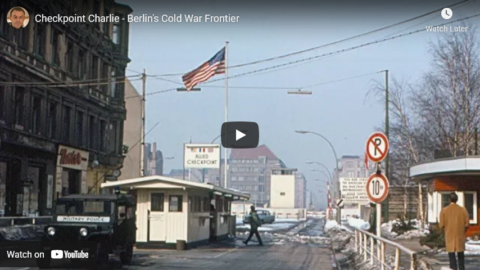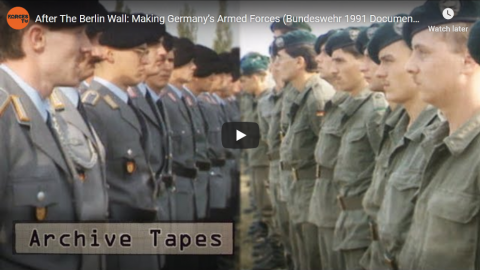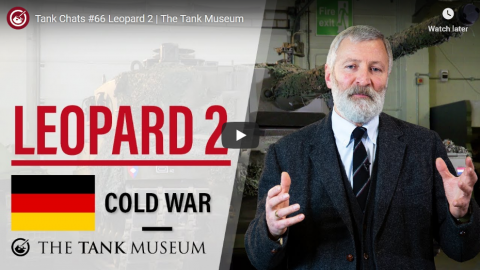Mark Felton Productions
Published 4 Dec 2018The history of Checkpoint Charlie, the most famous of Berlin’s East-West crossing points and the focus of a serious standoff between the US and Soviet Union in 1961 that could have led to World War III.
Support Mark at Patreon for $1 a Month!
https://www.patreon.com/markfeltonpro…
March 4, 2022
Checkpoint Charlie – Berlin’s Cold War Frontier
December 21, 2021
Tank Chat #136 | Schützenpanzer | The Tank Museum
The Tank Museum
Published 3 Sep 2021David Willey is back with another Tank Chat! This week’s episode is all about the Schützenpanzer. A West German infantry fighting vehicle developed from 1956 to 1958.
Support the work of The Tank Museum on Patreon: ► https://www.patreon.com/tankmuseum
Visit The Tank Museum SHOP & become a Friend: ► tankmuseumshop.orgTwitter: ► https://twitter.com/TankMuseum
Instagram: ► https://www.instagram.com/tankmuseum/
#tankmuseum #tanks
November 10, 2021
Tank Chats #131 | Kanonenjagdpanzer | The Tank Museum
The Tank Museum
Published 9 Jul 2021Curator David Willey discusses the German Cold War tank destroyer the Kanonenjagdpanzer or Jpz 4-5 for short.
Support the work of The Tank Museum on Patreon: ► https://www.patreon.com/tankmuseum
Visit The Tank Museum SHOP & become a Friend: ►tankmuseumshop.orgTwitter: ► https://twitter.com/TankMuseum
Instagram: ► https://www.instagram.com/tankmuseum/
#tankmuseum #tanks
May 2, 2020
After The Berlin Wall: Making Germany’s Armed Forces (Bundeswehr 1991 Documentary)
Forces TV
Published 5 Jan 2018It’s more than 27 years since German reunification, when East and West Germany came together again after the fall of the Berlin Wall. This documentary looks at the challenges facing the West German Army as they took over the East German National People’s Army.
Read more: http://www.forces.net/news/comment-bu…
Subscribe to Forces TV: http://bit.ly/1OraazC
Check out our website: http://forces.net
Twitter: https://twitter.com/ForcesNews
How things change … back in 1991, the Bundeswehr had a vast over-supply of military vehicles between the mass of Soviet-era equipment inherited from the DDR and the excess due to planned down-sizing of Germany’s overall military expenditure (the “peace dividend”). Earlier this year, Bild reported that German soldiers are being advised to take personal vehicles during military training exercises, due to a lack of infantry fighting vehicles and other military transport.
April 3, 2020
Tank Chats #66 Leopard 2 | The Tank Museum
The Tank Museum
Published 8 Feb 2019Curator David Willey gives chapter and verse on the German Main Battle Tank, Leopard 2, which first entered service with West Germany during the Cold War.
The Leopard 2 Main Battle Tank was kindly temporarily loaned to The Tank Museum by the Historic Collection of the Royal Netherlands Army.
Some stills and footage: © All rights reserved. (AR2011-0034-009, PA01-2016-0139-076, IS2010-3030-24, IS2011-1021-15, IS14-2017-0003-049, B11-ATHENA-020) reproduced with the permission of DND/CAF (2019)
At 8:55 Leopard 2 from The Arsenalen Museum, Sweden.
Support the work of The Tank Museum on Patreon: ► https://www.patreon.com/tankmuseum
Visit The Tank Museum SHOP: ► https://tankmuseumshop.org/
Twitter: ► https://twitter.com/TankMuseum
Tiger Tank Blog: ► http://blog.tiger-tank.com/
Tank 100 First World War Centenary Blog: ► http://tank100.com/ #tankmuseum #tanks #tankchats
June 1, 2019
Viper MkI: A Simplified Steampunk Sten
Forgotten Weapons
Published on 26 Apr 2019http://www.patreon.com/ForgottenWeapons
Cool Forgotten Weapons merch! http://shop.bbtv.com/collections/forg…
The Viper Mk I was an experimental submachine gun developed in the UK for use by military policemen in post-WW2 occupation West Germany. It was a simplified Sten gun (full-auto only, without the semiauto option normally included in the Sten trigger mechanism) put into a wooden housing. It was intended to be carried slung over one shouldered [and] fired under the arm with just one hand. To this end, it had neither sights nor trigger guard. The whole concept seems pretty questionable, and while multiple different Viper submachine guns were designed to fill this role, none were ever adopted.
Many thanks to the Royal Armouries for allowing me to film and disassemble this very rare weapon! The NFC collection there – perhaps the best military small arms collection in Western Europe – is available by appointment to researchers:
https://royalarmouries.org/research/n…
You can browse the various Armouries collections online here:
https://royalarmouries.org/collection/
Contact:
Forgotten Weapons
PO Box 87647
Tucson, AZ 85754
Experimental screen capture for social media thumbnailing purposes:
July 9, 2014
Thoughts on the “blitzkreig of Belo Horizonte”
Colby Cosh, self described as having descended from “multiple generations of German-killers” explains why he’s content with Brazil’s soccer disaster at the hands of the German national team yesterday:
It’s already being called “The Mineiraço”. Yesterday’s 7-1 slaughter of Brazil by Germany in the semifinals of the World Cup seemed an awful lot like a historical turning point, and the political ripples are already being discussed. Perhaps they are not even confined to Brazil, although the recriminations there are bound to be awesome: the government spent untold billions on a golden stage for Brazilian glory, and ended up with the sporting equivalent of the Challenger disaster, if Challenger had crashed intact into a packed stadium where the Pope was giving a homily.
What seems most remarkable to me is not the match itself but the prelude. I grew up in a colony of Anglo-Saxon Soccer World in which Germany was inevitably cast as a cartoon villain and Brazil was everybody’s second favourite national side. Brazil were what Canada fancies itself to be in hockey: the native “speakers” of the prestige dialect of the game — a national noblesse, possessing self-conscious power to establish, dictate, and impose its ideal form on lesser breeds. (Even Canadian children who played soccer were dimly aware of this: the rich ones would signify their coolness by wearing Brazil kit to practices, as I’m sure Bulgarian youth hockey players must signify to their mates by flaunting expensive Crosbiana.)
[…]
Anglo Soccer World seemed to be very much leaning toward Germany in the run-up to the Mineiraço. No doubt this is partly because we are getting ever further from the Second World War. Germany has been mostly tame, friendly, and progressive for 70 years, the Biblical specification of a human lifetime. The length of this period is approaching the duration of the trouble to which German hyper-German-ness subjected Europe between the Battle of Sedan and the Holocaust. It is hard to see any lingering trace of the old ills of the German national character in contemporary Germany.
Update: Compare the responses to yesterday’s game to the reaction after the 1954 West German team’s victory:
… the West German victory was hardly something that was welcome elsewhere in Europe, particularly to the authorities in East Berlin. Less than ten years after the end of a world war for which the Germans were held responsible, there was understandably little public enthusiasm in Britain and France at the outcome of the competition. Nonetheless the extent of the dismay and even vitriol at the time expressed in the media of both countries requires further explanation and points to deep-seated concerns in Britain and France about the speed of German economic recovery and re-armament in the mid-1950s.
For the East German regime, West Germany’s victory at the World Cup was the worst possible outcome. Communist leaders had been praying for a Hungarian win in order to prove the much-claimed ‘superiority of socialist sport’ and, by implication, the Communist form of government. Hungary’s defeat appeared to prove that the opposite was true, just at a time when East German leaders were trying to promote their state as the ‘progressive option’ for all Germans, as opposed to what they called the ‘Nazi successor state’ of the Federal Republic.
[…]
It was two events off the pitch – one immediately after the final and the other a few days later – that were to give ammunition to those keen to link the West German victory to allegations of resurgent German nationalism. First, as a rain-soaked Fritz Walter led his team up to collect the Jules Rimet trophy from the man whose name it bore and a Swiss band played the German national anthem, a boozy section of the German fans began singing the banned first verse of the national anthem – ‘Deutschland, Deutschland, über alles’ rather than the Federal Republic’s officially sanctioned third verse – ‘Einigkeit und Recht und Freiheit’ (unity, justice and freedom). Foreign journalists present immediately took note.
A few days later the damage was compounded by a speech given at the official victory celebration in a Munich beer cellar by the President of the German Football Association (Deutscher Fussball-Bund), ‘Peco’ Bauwens. In an atmosphere heavy with alcohol and emotion, Bauwens – who had joined the Nazi Party as early as 1933 – told the reportedly bemused players not only that they had been inspired by the spirit of the Nordic God, Wotan, but that victory had been made possible by their adherence to Der Führerprinzip. By this he appears to have meant unflinching obedience to a strategy worked out by the coach, Josef (Sepp) Herberger. The speech, which was being broadcast live by Bavarian Radio, was mysteriously cut short at this point and the tapes subsequently lost, but foreign reporters monitoring the coverage had already heard enough.
June 28, 2012
Don’t expect Korean re-unification to follow the German script of the 1990s
Some potentially chilling geo-strategic news from China:
The government has had reports issued denying American and Japanese studies of the rapid expansion of Chinese military power in the last decade. The Chinese reports were issued in Chinese, English and Japanese. China’s official line is that their armed forces are only for defense and are growing at a far more modest rate than foreign analysts are claiming. The Chinese are having a hard time refuting the foreign analysts, given the availability of satellite photos and many cell phone images of new Chinese weapons. China tries to control this sort of information leak, but has been unable to do so.
Another problem for China is the fact that internal propaganda campaigns cannot be kept secret from the outside world. This was never possible, but even with a heavily censored Chinese Internet, such embarrassing news quickly gets to an international audience very quickly. The latest example of this is remarks by Chinese officials about the “Great Wall of China.” The new claims are that the wall was larger than its current official size, and incorporates parts of North Korea. This was alarming news in South Korea, which is preparing to take over North Korea when the communist dictatorship up there collapses. The collapse is expected soon. With this new “Great Wall” argument the Chinese are announcing that if the North Korean government losses control, China will reclaim some “lost provinces” and the foreigners (including South Korea, Japan and the United States) had better stay out of it.
Given the Chinese claims in the South China Sea (that is, almost all of it), it is probably no surprise to the other nations that China might also have designs on part or all of the territory of modern day North Korea. When the German Democratic Republic (aka East Germany) collapsed in the early 1990s, the Federal Republic (West Germany) was able to pick up the pieces in a relatively co-ordinated manner. China may not want South Korea doing the same thing after a North Korean collapse.
March 24, 2012
The less-than-glamorous reality of Cold War spy work
A review of Steve Gibson’s Live and Let Spy: BRIXMIS – The Last Cold War Mission by Bill Durodié at spiked!:
Called the British Commander-in-Chief’s Mission to the Group Soviet Forces of Occupation in Germany, or BRIXMIS for short, it was part of an officially sanctioned exchange of observers between the Red Army and the British Army established by the victorious Allied powers and the USSR through the Robertson-Malinin agreement in 1946. Its ostensible purpose was to improve communication and relations between them.
In addition to BRIXMIS — and their French and American counterparts in the East — the Red Army also conducted similar operations through a unit in West Germany. But, diplomatic liaison and translation duties aside, the real purpose of these units soon became clear: to find out what each other was up to by heading out into those areas where they had been specifically told not to go.
[. . .]
For anyone who imagines that spying is glamorous, or somehow akin to being in a Bond movie, they will be disabused by Gibson’s chapter on document-gathering from dumps (literally). It had been recognised for some time that, when they went on manoeuvres in East Germany, the Soviet forces were not supplied with any toilet paper. They would use whatever came to hand — a copy of Pravda, a letter from a loved one, or even their mission papers. And after they were done, it was then that Her Majesty’s specially trained and equipped Cold War warriors really came into their own…
The book is republished with an expanded final chapter reflecting on what happened in the time following the fall of the Iron Curtain:
As a professor of political science at the University of Warwick, Robert Aldrich, notes in the new foreword, Gibson is now clearly of the mind that ‘much of what [he] was led to believe [during the Cold War], and some of what he was told, was simply wrong!’
[. . .]
Gibson’s resolute clearsightedness is to be admired. So despite having been caught up in the exhilaration of it all as a young man, despite devoting the prime of his life to the East-West conflict, he refuses to lie to himself. ‘The Cold War’, he notes, ‘was a giant historical cul-de-sac where all enlightened efforts at producing a good society were suspended’.
Aldrich astutely summarises a key argument of Live and Let Spy: ‘while Cold War warriors fought a tyrannical and ruthless version of Communism abroad, they remained ignorant of — and lost — an ideological battle at home’. He then adds accusingly: ‘Western politicians now offer a watered-down version of the interfering, intolerant, controlling and authoritarian government that they were initially set against rather than anything freer.’









